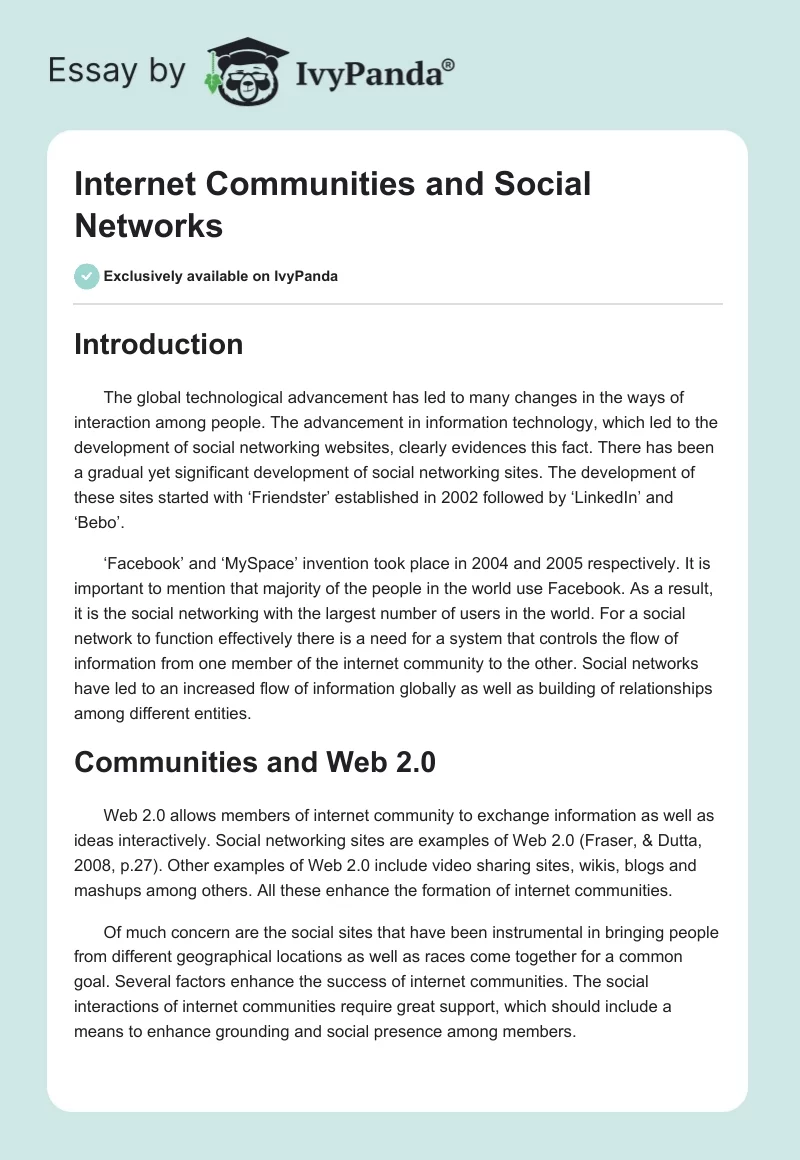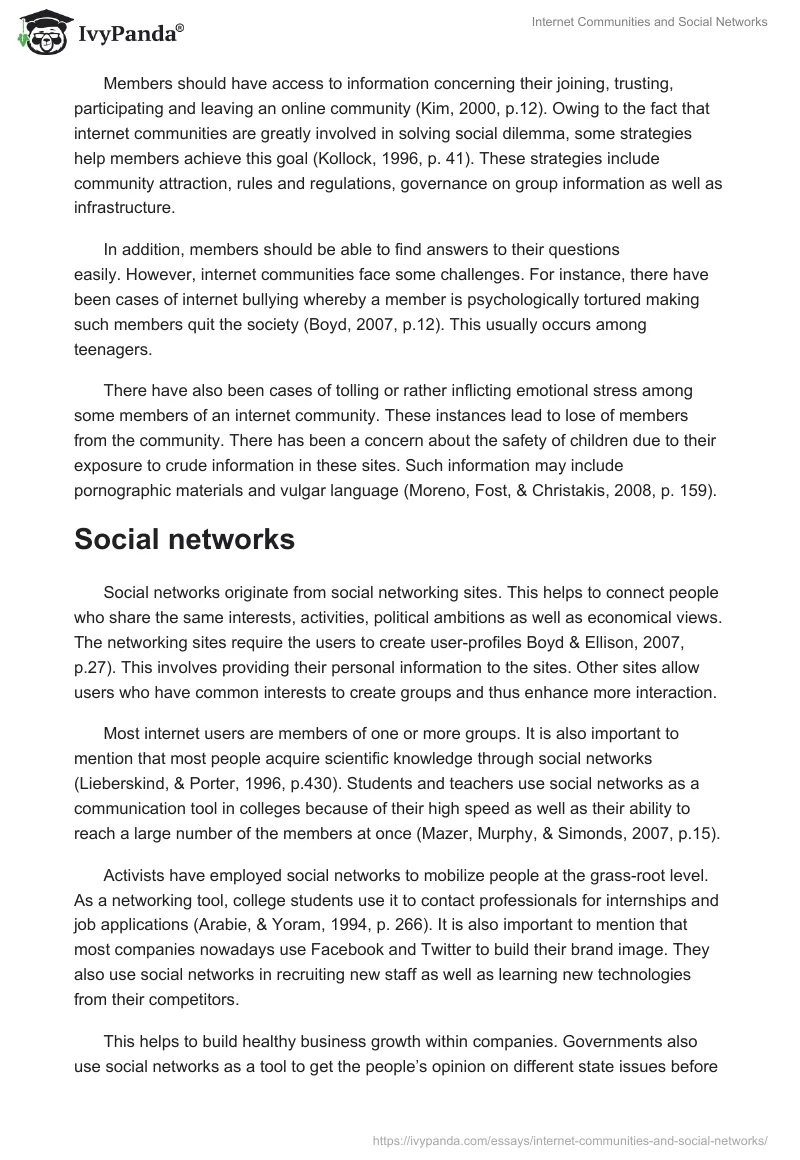Introduction
The global technological advancement has led to many changes in the ways of interaction among people. The advancement in information technology, which led to the development of social networking websites, clearly evidences this fact. There has been a gradual yet significant development of social networking sites. The development of these sites started with ‘Friendster’ established in 2002 followed by ‘LinkedIn’ and ‘Bebo’.
‘Facebook’ and ‘MySpace’ invention took place in 2004 and 2005 respectively. It is important to mention that majority of the people in the world use Facebook. As a result, it is the social networking with the largest number of users in the world. For a social network to function effectively there is a need for a system that controls the flow of information from one member of the internet community to the other. Social networks have led to an increased flow of information globally as well as building of relationships among different entities.
Communities and Web 2.0
Web 2.0 allows members of internet community to exchange information as well as ideas interactively. Social networking sites are examples of Web 2.0 (Fraser, & Dutta, 2008, p.27). Other examples of Web 2.0 include video sharing sites, wikis, blogs and mashups among others. All these enhance the formation of internet communities.
Of much concern are the social sites that have been instrumental in bringing people from different geographical locations as well as races come together for a common goal. Several factors enhance the success of internet communities. The social interactions of internet communities require great support, which should include a means to enhance grounding and social presence among members.
Members should have access to information concerning their joining, trusting, participating and leaving an online community (Kim, 2000, p.12). Owing to the fact that internet communities are greatly involved in solving social dilemma, some strategies help members achieve this goal (Kollock, 1996, p. 41). These strategies include community attraction, rules and regulations, governance on group information as well as infrastructure.
In addition, members should be able to find answers to their questions easily. However, internet communities face some challenges. For instance, there have been cases of internet bullying whereby a member is psychologically tortured making such members quit the society (Boyd, 2007, p.12). This usually occurs among teenagers.
There have also been cases of tolling or rather inflicting emotional stress among some members of an internet community. These instances lead to lose of members from the community. There has been a concern about the safety of children due to their exposure to crude information in these sites. Such information may include pornographic materials and vulgar language (Moreno, Fost, & Christakis, 2008, p. 159).
Social networks
Social networks originate from social networking sites. This helps to connect people who share the same interests, activities, political ambitions as well as economical views. The networking sites require the users to create user-profiles Boyd & Ellison, 2007, p.27). This involves providing their personal information to the sites. Other sites allow users who have common interests to create groups and thus enhance more interaction.
Most internet users are members of one or more groups. It is also important to mention that most people acquire scientific knowledge through social networks (Lieberskind, & Porter, 1996, p.430). Students and teachers use social networks as a communication tool in colleges because of their high speed as well as their ability to reach a large number of the members at once (Mazer, Murphy, & Simonds, 2007, p.15).
Activists have employed social networks to mobilize people at the grass-root level. As a networking tool, college students use it to contact professionals for internships and job applications (Arabie, & Yoram, 1994, p. 266). It is also important to mention that most companies nowadays use Facebook and Twitter to build their brand image. They also use social networks in recruiting new staff as well as learning new technologies from their competitors.
This helps to build healthy business growth within companies. Governments also use social networks as a tool to get the people’s opinion on different state issues before making major decisions. Too much of everything is dangerous. A number of social network users have grown into addicts (Boyd, 2006, p.62).
They spent too much time on these social networks to the extent that they overlook other important aspects of their life. Addiction is prevalent among Facebook users. It is important for members of any internet community to use these social networks wisely.
The impact of online networks on the community
As earlier mentioned online networks lead to increased flow of information in our communities. Online networks have been of much help to people with ill health especially those with chronic diseases (Battles, & Wienner, 2002, p. 52). On social networking interaction, these people are able to help each other to manage their ill conditions.
It is important to mention that they get to know people who they can identify with and helps to build a sense of acceptance. Online networks have also helped people to participate adequately in community activities by mobilizing people to attend activities leading to improved civic participation. The large numbers of people who join internet communities help to facilitate the mobilization.
For instance, according to a study carried out by The Centre of the Digital future, three quarters of Americans have internet access and spend 8.9 hours online weekly (Carvin, 2006).College students mostly practice this. Social networks also lead to formation of relationships between members of a given internet community. The issue of online dating came in from well-established ties between two members of a given online community (Romm, & Setzekon, 2008, p. 271).
They also help to increase communication between friends and family. According to Nielsen (2000), over 70% of online communities interact with their geographical communities on regular basis (p. 52). It is therefore evident that online communities enhance cohesion between members of geographical communities as well. Online gaming is a feature of most social networks.
Parents have had a difficult time in controlling their sons and daughters when it comes to computer games especially those who are still schooling (Knapp, 2006, p. 6). They believe that their children will perform poorly due to dedication of much of their time on these games. This therefore calls for parents to monitor the levels of their children’s involvement in online gaming. However, when well managed it is a good leisure activity.
Conclusion
Since invention of social networks in the late 1990s, online communities have both shown an increasing trend and wide acceptability. Social networks connect people sharing the same interests in life. For these networks to succeed there has to be a strong team supporting the networking sites. In addition, members of a given online community have to relate well in order to attract more people to these social networks. Consequently, social networks will exhibit tremendous growth.
Reference List
Arabie, P., & Yoram, W. (1994). Marketing and Social Networks. California: Sage Publications.
Battles, B., & Wienner, L. (2002). Star bright World: Effects of Electronic Network on The Social Environment of Children with Life-threatening Illnesses. Children’s Health Care, 31(1), 47-68.
Boyd, D. (2006). Friends, Friendsters and MySpace Top 8. Writing Community into Bery on Social Network sites, 11 (12), 60-67.
Boyd, D. (2007). Why Youth (Heart) Social Networking Sites. The Role of Networked Publics in Teenage Social Life, 2(4), 9-12.
Boyd, D., & Ellison, N. (2007). Social Network Sites: Definition, History and Scholarship. Journal of Computer-mediated Communication, 13 (1), 23-30.
Carvin, A. (2006). Understanding the Impact of Online Communities on Civic Engagement. Web.
Fraser, M., & Dutta, S. (2008). Throw Sheep in the Boardroom. How Online Social Networking will Transform your Life, Work and World. New York: Wiley.
Kim, A. (2000). Community Building on the Web. Berkeley: Peachpit Press.
Knapp, E. (2006). A Parent’s Guide to my space. New York: Day Dream Publishers.
Kollock, P. (1996). Design Principles for Online Communities. Harvard.
Lieberskind, K., & Porter. J. (1996). Social Networks, Learning and Flexibility. Sourcing Scientific Knowledge in New Biotechnology Firms. Organization Science, 7(4), 428-443.
Mazer, J., Murphy, R., & Simonds, J. (2007). I’ll see you on Facebook: The effects and Classroom Climate. Communication Education, 56 (1), 1-17.
Moreno, A., Fost, C., & Christakis, A. (2008). Research Ethics in the MySpace Era.Pediatrics, 121(1), 157-161.
Nielsen, J. (2000). Designing Web Usability. The Practice of Simplicity. Indianapolis: New Riders Publishing.
Romm, L., & Setzekorn, K. (2008). Social Networking Communications and E.Dating Services: Concepts and Implications. New York: Information Science Technology.


